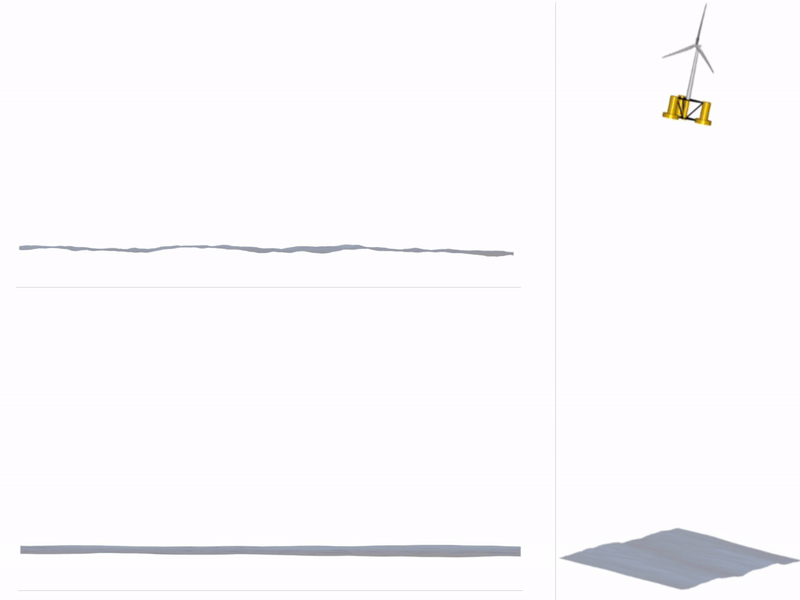Forum
Important Notice for New User Registrations
To combat an increasing number of spam and bot registrations, we now manually approve all new user registrations. While this may cause a delay until your account is approved, this step is essential to ensure the quality and security of this forum.
To help us verify your registration as legitimate, please use a clear name as user name or an official email address (such as a work, university, or similar address). If you’re concerned that we may not recognize your registration as non-spam, feel free to email us at with a request to approve your username.
Output of Sensor in sub structure
Quote from David on 15. April 2024, 13:22Hi,
the most effective method to determine the reaction force between the jacket and the ground is to extract the reaction forces directly from the ground constraints specified using the CST_X keyword.
See here: https://docs.qblade.org/src/user/turbine/substructure.html#defining-sensors-locations
Check in the substructure constraint table which constraints fix the jacket structure to the ground and then assign sensors to those constraints. The reaction forces are then given in the global coordinate system (for constraints connected to the fixed ground).
BR,
David
Hi,
the most effective method to determine the reaction force between the jacket and the ground is to extract the reaction forces directly from the ground constraints specified using the CST_X keyword.
See here: https://docs.qblade.org/src/user/turbine/substructure.html#defining-sensors-locations
Check in the substructure constraint table which constraints fix the jacket structure to the ground and then assign sensors to those constraints. The reaction forces are then given in the global coordinate system (for constraints connected to the fixed ground).
BR,
David
Quote from mnaeem on 16. April 2024, 10:25Hi,
The issue that I am facing is that the hydrodynamic load from Q-blade for a jacket is very different compared to the hydrodynamic load from SACS or hand calculation. Do you know if the hydrodynamic load calculation has been verified for fixed structures?
I have attached the file, I am doing an analysis with just hydroloads.
Hi,
The issue that I am facing is that the hydrodynamic load from Q-blade for a jacket is very different compared to the hydrodynamic load from SACS or hand calculation. Do you know if the hydrodynamic load calculation has been verified for fixed structures?
I have attached the file, I am doing an analysis with just hydroloads.
Uploaded files:- You need to login to have access to uploads.
Quote from David on 16. April 2024, 13:58Hello,
the hydrodynamic load models in QBlade, including those based on Morison’s equation and Potential Flow, have undergone extensive verification through both experimental and numerical data. Although most validation efforts have focused on floating structures, we also tested on fixed structures (currently ongoing in OC7) and the results should generally be transferrable.
Of course, the accuracy of hydrodynamic load calculations depends significantly on the distributed Morison coefficients or the quality of the potential flow data.
Any discrepancies you’re experiencing might be due to setup issues, but it’s difficult to ascertain this from just a project file. Could you provide your reference data and explain how it compares to the results from QBlade? Specifically, it would be interesting to know the measured quantities and the positions at which they were recorded. Including plots in your response would also be helpful to identify issues.
BR,
David
Hello,
the hydrodynamic load models in QBlade, including those based on Morison’s equation and Potential Flow, have undergone extensive verification through both experimental and numerical data. Although most validation efforts have focused on floating structures, we also tested on fixed structures (currently ongoing in OC7) and the results should generally be transferrable.
Of course, the accuracy of hydrodynamic load calculations depends significantly on the distributed Morison coefficients or the quality of the potential flow data.
Any discrepancies you’re experiencing might be due to setup issues, but it’s difficult to ascertain this from just a project file. Could you provide your reference data and explain how it compares to the results from QBlade? Specifically, it would be interesting to know the measured quantities and the positions at which they were recorded. Including plots in your response would also be helpful to identify issues.
BR,
David


